#i feel deeply uncomfortable selling my art that for example is the piece that made me stop being able to knead dough by hand
Note
I know you've talked about your frustration with how difficult it is to make money with fiber art, but would you ever consider selling or trading for the dyed fleece you have? Not like opening an etsy shop and dying fleece just for selling or anything. But like, say I wanted to buy some hand veg dyed wool...you could destash some of what you have....then you could use that money to dye more wool.....infinite wool hack.
I trade my stuff all the time (and am always down to trade hand made and hand processed stuff for other handmade/hand processed !). I dunno if selling dyed fleece would actually be an infinite wool hack though; I haven't really done the math but like, if I buy 2 pounds of raw fleece for $25 (definitely a price I've paid before, idk if its standard for me off the top of my head), once I wash it I likely have anywhere between a pound and a pound a half (depending on breed and how dirty it was, the lanolin and dirt that I wash away can be up to 70% of the weight of a raw fleece, but usually closer to 50% in the breeds I like working with). So I'd have to sell a single pound of washed dyed fleece for like $35 ($10 shipping for 1 pound package is what I just paid at the post office a few days ago) just to get the money back from what i paid for the fleece in the first place--basically paying in labor and foraged materials (so more labor) for the joy of getting to dye wool for strangers. Idk about that. I'd definitely do it if it looked like I could get at least double the cost of the wool for it--Maybe people would pay a lot more, but I'd be a little surprised if that were true, honestly. It's a very nice idea and i wish the world worked that way :(
#as it is i just trade/gift away most of my wool#wool processing#no-pants-dan#adding price tags to my stuff tends to just make me feel like shit#because 1) it never ever moves the meter on how much money i need to survive each month#2) theres not a single thing i can do that doesnt cost in pain. not just time but pain and frequently the clear and measurable#degradation of my body per project#my body will degrade anyway becauae i have no choice but to find some kind of work#but at least the other work pays better and usually degrades my body slower#i feel deeply uncomfortable selling my art that for example is the piece that made me stop being able to knead dough by hand#id kinda rather keep it bc if i cant knead dough by hand anymore at least i can look at the physical manifestation#of what caused me to not be able to do that anymore#idk if that makes any sense#i suspect not bc ive been trying to explain this to my family for literally years#and they do not get it at all#i finally got them to shut up about it only by telling them i will no longer talk about it and if they ask i will leave the room#yay for boundaries. now i just need to get over how angry even being asked that question now makes me. lol
18 notes
·
View notes
Text
How Fandom Adds Meaning to Mario (and Other Characters): The Legacy and Impact of Fan Art
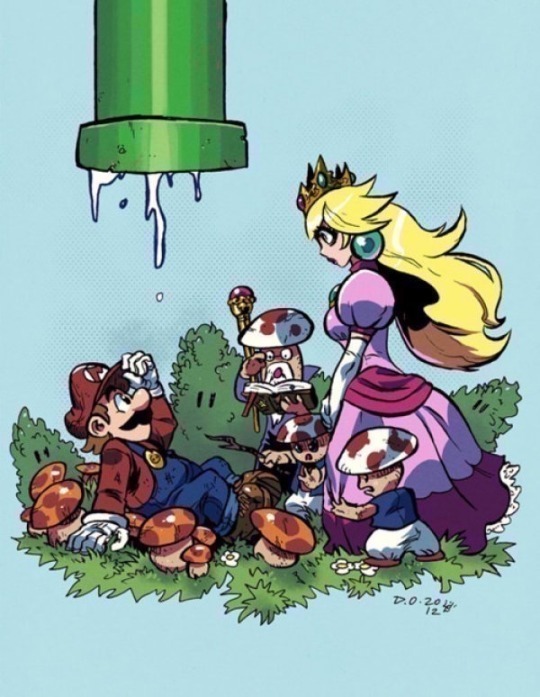
By Matt O’Keefe
A lot of games are fun , though entertaining, lack a sense of exploration. That probably indicates a lack of an “open world” to most, but in my eyes can also indicate an absence of exploration of character, theme, or purpose. Nintendo games are more susceptible to this trait than most. 2D Mario games, for example, usually take you from Point A to Point B to Point C, without much in-between. The same applies to Kirby and Yoshi and Star Fox titles. Even Zelda games are primarily dedicated to a core mission, though Breath of the Wild certainly deviated from that pattern. This piece is by no means a vilification of that style, but, because of the Nintendo properties’ straightforward A-to-Z progression, those franchises often don’t get the opportunity to explore the ways other games can. So that’s where the fans come in.
Deeply invested in the characters and worlds they grew up with, fans want to enrich what has already been put before them. Because Nintendo characters are often less developed on a character level, they receive the biggest [upgrades]. That’s why fan artists, whether they be illustrators, musicians, columnists, or another type of creatives, have been able to add so much to Mario and his Nintendo brethren. Keep reading to learn the many ways fans can and have supplemented and enrichened what so many gamers already love.
Character Development
Though the mainline Mario games are mascot platformers, they feature a mascot without much of a personality, especially compared to successive characters like Sonic and Ratchet & Clank. Mario is not someone to get to know over the course of your journey. You control him but never identify with him, which is why he’s often referred to as a cipher. Nintendo is putting his identity, along with his fate, into fans’ hands. Since the release of the first Super Mario Bros on the NES, maybe even earlier, fans have done their duty forging the red-clad plumber and similarly blank canvas Nintendo characters over the past 35 years.
The best example of the sophistication of simple ideas is perhaps the work of Zac Gorman. Gorman creates GIF comics featuring all kinds of video game characters. His Mario pieces are particularly poignant because they breathe life and purpose in a character who essentially has none.
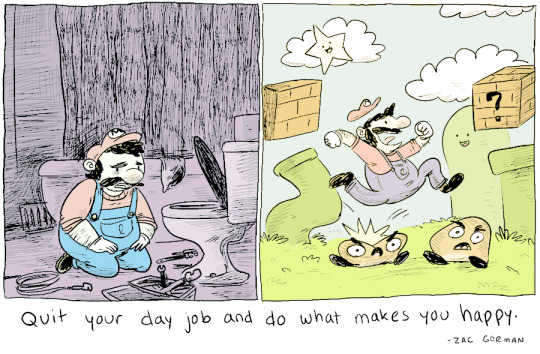

Art by Zac Gorman
Messages, like pursuing your passions and overcoming fear, aren’t inherently complicated, but they can be poignant, especially aligned with artwork filled with emotion. The work Gorman and others have affected my own thoughts while playing, giving me new reasons to care. I trek across the Mushroom Kingdom knowing Mario loves his new gig, making his constant smile so much more meaningful. I sympathize with Luigi for being under the shadow of his more popular brother, which deepens his arc in Luigi’s Mansion as he sets out on his own for the first time. Just because a game doesn’t have a script on the level of The Last of Us doesn’t mean it can’t endear you to its characters, with a little help from the fans.t
This kind of enrichment can also be done for characters with a little more agency. Link, the hero of Legend of Zelda, usually has some kind of backstory and motivation, but fans do a great job instilling more of both in him through their art. Zac Gorman has made over a dozen comics doing exactly that. Here are some of my favorites.


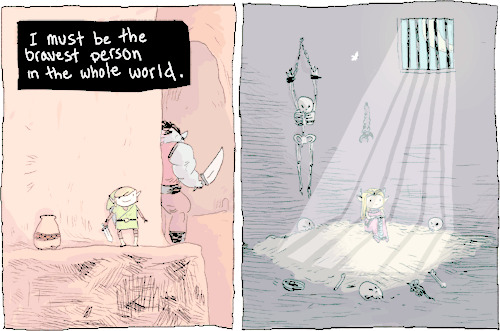

Art by Zac Gorman (again)
He’s not creating an amazingly rich and complex backstory, choosing instead to pinpoint the moments in stories that resonate and demonstrate fundamental ideas, foremost why Link is a hero.
Worldbuilding
The various games in Nintendo series were probably never meant to have cohesive histories. But fans wanted them, so they got them. Nintendo itself released Hyrule Historia due to the demand for a continuity to the Zelda series, but more often the worlds of video game characters are fleshed out by fans. There’s the Super Mario Timeline, a video tracking all the Mario games and trying to somehow make sense of how they all fit together. Artist Bill Mudron even sells gaming maps, depicting some of our favorite fictional worlds as cartography. One that hangs on my wall combines all the known parts of the Mushroom Kingdom from the NES and SNES eras.

Art by Bill Mudron
You can debate whether the map perfectly matches what’s laid out in the games and their manuals (many have), but it’s a testament to the dedication of fans that things of this kind even exist.
Mudron has also created multiple maps of Hyrule. They’re a bit easier to get right people of the way Zelda games are _________, but still might not be exact. But there’s something special about that imperfection, which allows Mudron’s interpretation of the worlds of classic Nintendo franchises to [shine brighter].

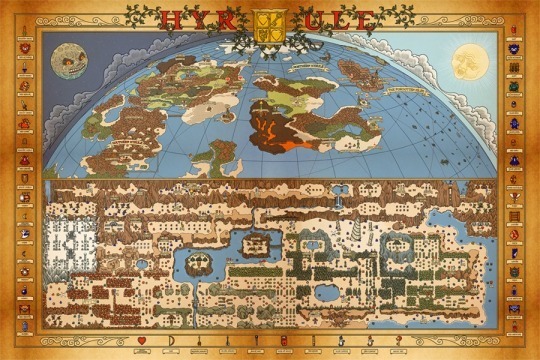
Art by Bill Mudron (again)
Mudron’s maps and the timeline are examples of creations that require a lot of time, research and effort. But sometimes worldbuilding can be as simple as picking out the moments you don’t see in a game that make the world feel like a bigger and realer place, like this piece of art featuring a certain Italian plumber taking a lunch break on his construction job.

Art by ________
Or fan art can make us rethink parts of the world just by pointing out silliness we don’t think twice about when we’re immersed in the game.

Art by Zac Gorman (last time, promise)
Whatever the method, artists have enriched the world these characters inhabit in ways developers didn’t or couldn’t within the context of their games, and we should be grateful for it.
Style
The most obvious thing fan art can do is add a unique flair to the characters and worlds of video games. It’s a lot easier and a lot quicker for an artist to do a drawing of a character in their style than for a video game developer to create a game with a groundbreaking design choice. They’ve tried it on a few occasions, Nintendo recently with Yoshi’s Wooly World, but it’s more time consuming and risks alienating audiences that are already satisfied with the original molds.
My favorite cartoonist, Scottie Young, sometimes spotlights a Nintendo character with his Daily Sketches.
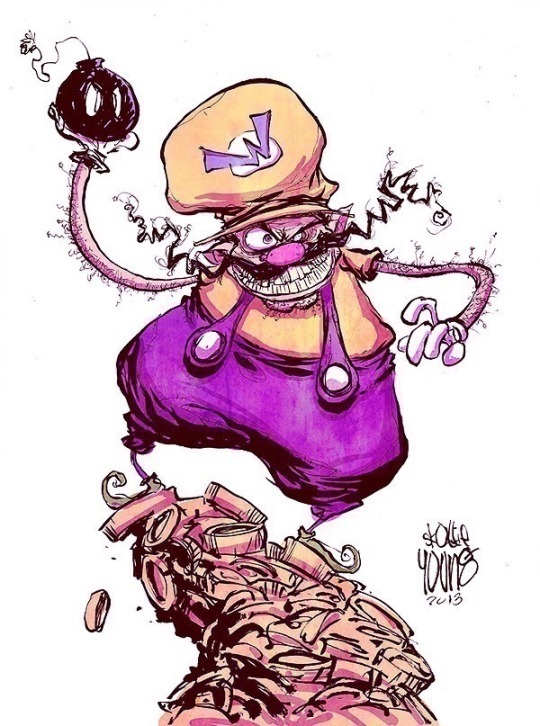
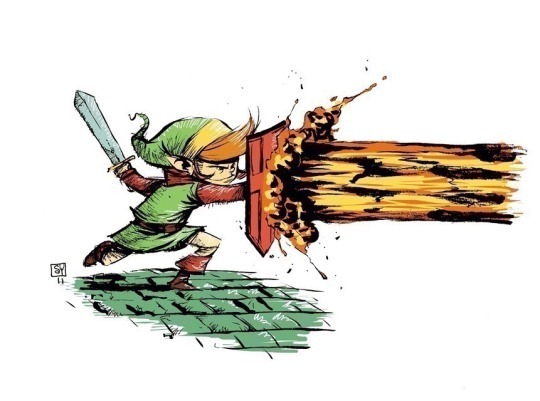
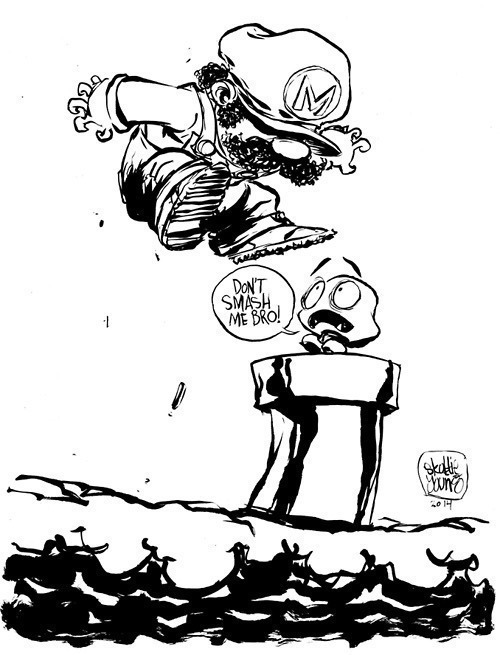
Art by Skottie Young
But there’s no shortage of examples of great, unique interpretations of game characters in media. I have a sketchbook of my own filled with artists’ takes on various Nintendo characters that I hope to share with you later. For now, here are more polished illustrations.

Art by Chrissie Zullo

Art by Nick Derington

Art by Riley Rossmo
Depth
Most Nintendo games aren’t trying to say something, but fans can say it for them. Talents across the world instill meaning within the games through their art. They can, for example, use satire to point out prejudice.

Art by Eduardo Salies
They can use a captivating image to advance social awareness.
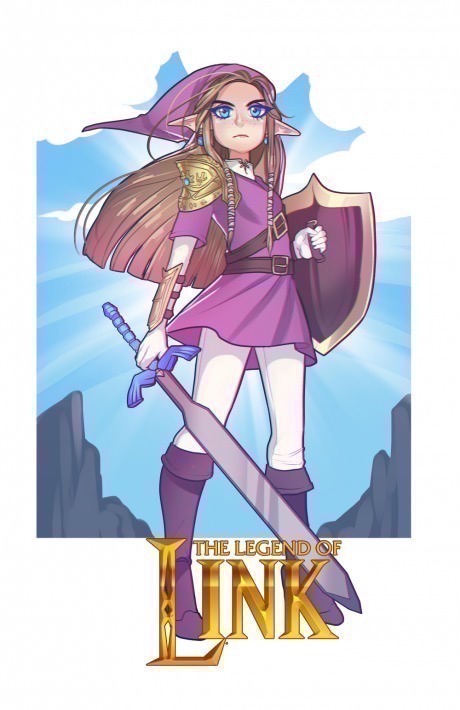
Artist unknown
Or even force us to reflect on uncomfortable but important subjects, such as violence in video games.

Art by Nick Derington (again)
[Wrap up article here]
There are so many artists and creators that want to have an influence on the things they loved, and there’s very little that inspires more fandom than Nintendo. Keep in mind how they can change perception, add layers and bring the worlds alive when you’re scrolling through recent fan art. You’ll be glad you did.

Do you like what you just read? Do you know fan art that similarly enriches video game characters and worlds? Sound off in the comments below!
Cover image art by weremole
2 notes
·
View notes
Text
What molded my practice in design?
Korean society is often said to be a high pressure society. Having lived in it for more than 24 years, I have to agree with this completely. My theory is that so many people live in such a small country, that people always need to compete with each other and basically it became the survival of the fittest. Of course, Koreans trying to rebuild the country after the Korean War and accomplish the miracle of Han river kind of all helped make how we are this way now.
In high school, all I did was think about how to get to a good university and study since 8am until 10pm, having not much life outside. We were learning only to get good grades, not for the joy of learning. When everything is about excelling, fun goes away. It was the same with art and music. We covered so many different topics, like the basis of conducting(Yes, like conducting the orchestra), which my western friends were surprised about. So even though I was always interested in different areas of art and especially photography, I only had to see them through the society’s eyes and ask, ‘Could I be successful with that? Do I have the talent? Could I make money out of it?’. So I gave up on those things and decided to major in Business in university.
I was lucky to have the chance to live in the States when I was 4, due to my father’s profession. Ever since, the experience living abroad was ingrained deeply in my brain which made me admire the different lifestyle, culture and education system they have. Something freer. Also knowing English a little more than my peers made it easier for me to have a peak into that different culture. The way people make jokes, talk, dress and think. This made me feel that I have more knowledge in things than others. I was listening to British pop(it was not so common to listen to it among my friends!) and Japanese visual rock, watching movies that no one knew about and dressing in vintage clothes. I would collect rare albums and I had more than 100 albums in the end. Though introverted when I was young, having these hobbies and taste made me feel somehow special. However when I started making decisions not for myself but for other’s expectations I started giving up on a lot of things I liked and as somehow they started to be valueless on my written path of going to a good university, getting a good job and living a wealthy life.
Then I had the chance to move to Prague. I felt so much freer just being out of Korea, and being able to travel so much and see a lot of different things broadened my point of view. I learned also from the people I met, who talked about and pursued things they genuinely wanted. They were more open minded and accepting of different tastes and preferences others have which made me so comfortable to just be myself. I was working in the business sector and dealing with Korean customers so I still felt a bit trapped to that standard of society. Then, I decided to quit and do something different - finally something I liked. That’s when I started the Graphic Design program in Prague College.
Even though people who knew me from before wasn’t surprised of my choice, since I have been interested in art and I have been creative in my daily life by posting photographs on social media and organizing events with DIY decorations in the flat, I still felt like a different person and it was so liberating. Friends around me even told me that I dress differently and even my personality had changed.
So how did this background of mine influence my taste? First of all, I became more open about what I like and gained confidence in my taste. Also, having had studied business and been bombarded by advertisements in Korea, I started to be quite sick of anything too commercial. For example ads with super stars or using instagram ‘influencers’ to sell products always makes me feel uncomfortable. This is why in my graphic design, I prefer to do something that I can express myself or something related with a good cause rather than making images to make sales. Still I appreciate the utilitarian values and so a good balance of practicality and the aesthetically value would win my heart in product design. Also I don’t think everything expensive is considered good taste like it used to be in the past, but now more like knowing how to collaborate different style of things is good taste. Being able to create a room full of different prices and style of furniture based on a good eye (from knowledge and experience) would be one example.
When appreciating art, I try to enjoy the aesthetic part a lot of art and design, and see what makes me feel happy and makes me feel that it is beautiful and interesting. As mentioned above, I learned art from books, and going to museums was a must for education. However now I believe you need to be able to enjoy art rather than always studying it(of course, I am not saying the intellectual part of appreciating art is not enjoyable). There is no one answer in appreciating art like Roland Barthes said. We can interpret everything in our own way and if that resonates somehow within you then you have gained something from that piece of art. This I felt the most when I was in the Biennale in Venice over the weekend, cause I was able to go through the exhibition as if it was a playground, interpreting them as I observed and understood. It was just so exciting to be in that amazing space filled with different ideas, colors and media and some pieces were very moving, some were just so mind blowing in production and some were very beautiful. They provoked all different sorts of thoughts and sparks in me and I think that is what is important in how we see art as individuals, making ourselves even individual ‘producers’ of art.
0 notes